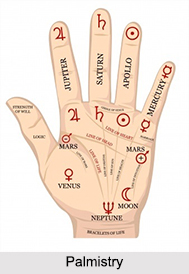 Palmistry or ‘Hasta Rekha Vigyan’ is the most popular branch of Samudrik Shastra. The original Samudrik Hasta Rekha embodies Vedic philosophy within itself in a coalition with all the cosmic forces available. Up to 153 lines are recognized and studied well in the palm. A more spiritual insight in the readings is done by defining and studying the Atma Rekha.
Palmistry or ‘Hasta Rekha Vigyan’ is the most popular branch of Samudrik Shastra. The original Samudrik Hasta Rekha embodies Vedic philosophy within itself in a coalition with all the cosmic forces available. Up to 153 lines are recognized and studied well in the palm. A more spiritual insight in the readings is done by defining and studying the Atma Rekha.Basics of Palmistry
The art of analyzing the Palm as a blueprint of a person’s past, present, future, karmas and personality and life issues originated in the ancient mystique land of India. The hands of every individual are the constant recipients of the continuous flow of electrical impulses from the brain. The coordination between the conscious and subconscious mind with that of the hands is almost miraculous. The nerve endings and energy flow in the palm is responsible for etching out the presence of lines and mounts on them. Studying these lines and other signs to know the details about a person comes under the practice of palmistry. Every sign in the palm foretells something about the characteristic, talents, strengths etc. of a person. Since the free will of the person is the most important cosmic force of all, palm lines and signs are changeable through the changing circumstances in human life.
Features of Palmistry
Palmistry commences with the obvious things and goes forward with countless elaborate affairs followed by proper judgment and elucidation that lead to the ultimate foretelling of an individual. The hands of individuals are reckoned as active and passive hands. In Palmistry, the passive hands are of great importance as it has been considered that the passive hands transmit innate human characteristics and the active hand entails the ‘karma’ of the individuals. Even as per Vedic Palmistry, the passive hands convey the karmic imprint of a person or the past life of a person. The study of Palmistry is dependent on reading the mounts of the palm, the lines in the palms, and the structure of fingers.
Techniques of Palmistry
In palmistry, the reader usually starts reading the dominant hand of the person which is the hand an individual uses the most. It is believed that this hand represents the conscious mind which the other one signifies subconscious mind. However, according to some traditions, the other hand is believed to carry hereditary or family traits. Some also believe that it conveys information about past life. The choice of hand depends entirely on the instinct and experience of the practitioner. The left hand is generally controlled by the right brain and is believed to reflect the inner person, the lateral thinking and the natural self. On the other hand, the right brain is controlled by the left brain and is thus indicative of the outer person, the influence of experience, education and social environment and linear thinking.
For more visit the link below: